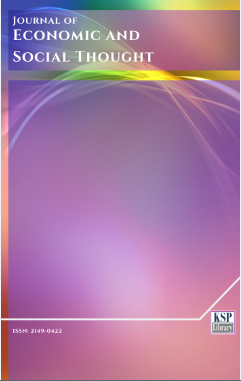Multiple jobs holding and management of lecturers in Cameroonian state universities
Abstract
Abstract. This article is a continuation of our previous works on the determinants of multiple jobs of lecturers in Cameroonian State universities. It lays particular emphasis on human resource management used in these universities. The methodology makes use of the logit analysis on survey data. The results obtained show that contrary to the theoretical and empirical literature, time constraint in the main job does not appear to be an important explanatory factor for the multiple jobs phenomenon. However, gender, the universities’ location, salary earned from secondary jobs and the holding of an administrative position in a university play a major role in explaining the phenomenon. This paper thus presents a certain interest linked to the specificity of these jobs (lack of monitoring, opportunism in behaviors, social pressures related to them) on the one hand, and the coaching of the human resource used on the other. Governmental incentive measures are proposed to limit this dual employment phenomenon which tends to deteriorate the quality of lectures provided.
Keywords. Moonlighting, State University, Odds ratios, Logit model, Monitoring and Coaching tools, Cameroon.
JEL. J50, J24, J31, J81, C35.
Keywords
References
Abdulkadir, G. (1992). Liquidity constraints as a cause of moonlighting, Applied Economics, 24(12), 1307-1310. doi. 10.1080/00036849200000090
Ahn, N., & Rica S. (1997). The underground economy, Applied Economics, 29(6), 723-743. doi. 10.1080/000368497326660
Azariadis, C., & Stiglizt, J. (1983). Implicit contrats and fixed price equilibria, Quarterly Journal of Economics, 98(3), 1-22. doi.
Braithwaite, J. (1994). From second economy to informal sector: The Russian labor market, (in transition), Mimeograph, Washington, DC: The World Bank. [Retrieved from].
Commander, S., & Tolstopiatenko, A. (1997). A model of the informal economy in transition economies. Ann Arbor, MI: William Davidson Institute at the University of Michigan Business School Working Paper, No.122. [Retrieved from].
Conway, K., & Kimmel, J., (1995). Who moonlights and why? Evidence from the SIPP. W. E. Upjohn Institute Staff Working Paper, No.95-40. [Retrieved from].
Conway, K., & Kimmel, J. (1998). Male labor supply estimates and the division to moonlight, Labor Economics, 5(2), 135-166. doi. 10.1016/S0927-5371(97)00023-7
Ehrlich, I. (1973). Participation in illegitimate activities: A theoretical and empirical Investigation, Journal of Political Economy, 81(2), 521-565. doi. 10.1086/260058
Foley, M. (1997). Multiple job holding in Russia during the transition, Mimeograph, Yale University. [Retrieved from].
Goodwin, B.K., & Mishra, A.K. (2004). Farming efficiency and the determinants of multiple job holding by farm operators, American Journal of Agricultural Economics, 86(3), 722-729. doi. 10.1111/j.0002-9092.2004.00614.x
Grossman, A. (1974). Multiple Jobholding in Special Labor Report 177, U.S Department of Labor.
Guhrie, H.W.(1965). Who moonlights and why?, Ill. Bus. Rev., 22, 6-8.
Guhrie, H.W. (1969). Teachers in Moonlight, Mon.Lab.Rev. 92, 28-31.
Guariglia, A., & Kim, B.Y. (2004). Earnings uncertainty, precautionary saving and Moonlighting in Russia, Journal of Population Economics, 18(2), 289-310. doi. 10.1007/s00148-004-0184-3
Hamel, H.R, (1967). Moonlighting- An Economic Phenomenon, Mon. Lab Review, 90, 17-22.
Henderson, D.L., Darby, C.E., & Maddux, C.D. (1982). Moonlighting, salary, moral, and the approaching teacher shortage: A follow-up study. Texas State Teachers Association. ERIC Document Reproduction Service, No.ED-223-594. [Retrieved from].
Kim, B.Y. (2005). Poverty and informal economy participation in transition countries: Evidence nom Romania, Economics of Transition, 13(1), 163-186. doi. 10.1111/j.1468-0351.2005.00211.x
Kolev, A. (1998). Labor supply in the informal economy in Russia during transition. London: CEPR Discussion Paper No.2024. [Retrieved from].
Krishnan, P. (1990). The economics of moonlighting: a double self selection model, Review of Economics and Statistics, 72(2), 361-367. doi. 10.2307/2109729
Lazear, E. (2004). Salaire à la performance: incitation ou sélection? Economie et Prévision, 3(4), 164-165.
Levenson, A.R. (1995). Where have all the part-timers gone? Recent trend and new evidence on dual-jobs, Milken Institute for Job and Capital Formation Working Paper, No.95-1. [Retrieved from].
McGinley, L.D. (1979). Outside jobs for teachers may affect effective performance in the classroom. Updating School Board Policies, 10(12), 1-3.
Moses, L.N. (1962). Income, leisure, and wage pressure, The Economic Jounal, 72(286), 320-334. doi. 10.2307/2228670
O’Connell, J.F. (1979), Multiple job holding and marginal tax rates, National Tax Journal, 32(1), 73-76.
Parham, J., & Gordon, S.P. (2011). Moonlighting: A harsh reality for many teachers. The Phi Delta Kappan, 92(5), 47-51. doi. 10.1177/003172171109200511
Paxon, H.C., & Sichermann, N.(1994). The dynamic of dual job holding and job mobility, NBER Working Paper, No.4968. doi. 10.3386/w4968
Paxon, H.C., & Sicherman, N. (1996). The dynamics of dual job holding and job mobility, Journal of Labor Economics, 14(3), 357-393. doi. 10.1086/209815
Pearson, L.C., Carroll, D., & Hall, B.W. (1994). Analysis of demographic, perceptual, and work-related factors in teacher moonlighting. The Journal of Educational Research, 87(5), 304-308. doi. 10.1080/00220671.1994.9941258
Perlman, R. (1969). Labor Theory, Wiley: New York.
Rose, R. (1994). Getting by without government: Every life in stressful society. Glasgow, Scotland: Centre for the Study of Public Policy, University of Strathclyde, Studies in Public Policy Working Paper No.227. [Retrieved from].
Shishko, R., & Rostker, B. (1976). The economics of multiple job holding, American Economic Review, 66(3), 298-308.
Stankiewiez, F., & Lene, A. (2011). Economie des Ressources Humaines, La Découverte, Paris.
Texas State Teacher Assocation (TSTA) (2006), Study: Almost Half of Texas Teachers Could Leave the Profession. News release. [Retrieved from].
Theisen, T. (2005). Tanzanian formal sector workers participation in informal production, Applied Economics, 37(21), 2469-2485. doi. 10.1080/00036840500366197
Winan, D. (2005) The Bill's come due. EA Today, Oct. 1, 24-29.
Wisniewski, R., & Kleine, P. (1984). Teacher moonlighting: Unstudied phenomenon. Phi Delta Kappan, 65(8), 553-555.
Yamb, B., & Bikoue, M. (2016). The determinants of moonlighting among lecturers of state universities in Cameroon: An evidence from a log-linear model, Research in Applied Economics, 8(3), 19-48. 10.5296/rae.v8i3.8795
DOI: http://dx.doi.org/10.1453/jest.v6i2.1880
Refbacks
- There are currently no refbacks.
Journal of Economic and Social Thought - J. Econ. Soc. Thoug. - JEST - www.kspjournals.org
ISSN: 2149-0422
Editor: [email protected] Secretarial: [email protected] Istanbul - Turkey.
Copyright © KSP Library




